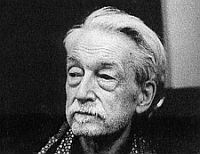 Devon, PA. In the early pages of Jacques Maritain’s Art and Scholasticism, he provides a philosophy of art that restores “art,” in the sense of the fine arts, to its proper status as the particularly intellectual, singularly human, form of work. Artists and artisans are one; and while all living creatures may work in some fashion, art, the making or reifying of an idea in matter, captures in a way no labor can the dignity proper to the embodied rational animal. When the artisan makes something, he demonstrates the centrality of ideas to human life even as he affirms that ideas, for men, become most real when concretized: the fine arts honor the senses of our body just as the instrumental arts serve us in our bodily condition. Thus, his treatise gives us an important definition of the fine arts in relation to work as craft — an always timely reminder for those engaged in the fine arts. But he also provided the foundations for the rich anthropological and theological reflections on work and the dignity of man, which became central to Catholic social doctrine in the last century, as it sought to combat the dehumanizing “liberation” of Marxist labor theory.
Devon, PA. In the early pages of Jacques Maritain’s Art and Scholasticism, he provides a philosophy of art that restores “art,” in the sense of the fine arts, to its proper status as the particularly intellectual, singularly human, form of work. Artists and artisans are one; and while all living creatures may work in some fashion, art, the making or reifying of an idea in matter, captures in a way no labor can the dignity proper to the embodied rational animal. When the artisan makes something, he demonstrates the centrality of ideas to human life even as he affirms that ideas, for men, become most real when concretized: the fine arts honor the senses of our body just as the instrumental arts serve us in our bodily condition. Thus, his treatise gives us an important definition of the fine arts in relation to work as craft — an always timely reminder for those engaged in the fine arts. But he also provided the foundations for the rich anthropological and theological reflections on work and the dignity of man, which became central to Catholic social doctrine in the last century, as it sought to combat the dehumanizing “liberation” of Marxist labor theory.
In the latest installment (Part V) of my essay, Art and Beauty against the Politicized Aesthetic, I reflect on Maritain’s philosophy of art and work. But this is one plank within an increasingly vast platform, and so you may enjoy reading the earlier installments. The relevant passage in Part V runs:
If Maritain grants with qualifications the modern notion of art as autonomous and as having a self-absorbing and undeviating telos for the work made, he steers a more careful course between two other modern misconceptions. Above all, romantic and post-romantic aesthetics often reduce—or “elevate”—art to a kind of excretion, whether as the leaves on the trees or something more visceral. Conversely, in Maritain’s day, self-styled neo-classicists held up Racine as the model of art as an ornamental exercise of the reason, or wit (l’esprit), of perfect method devoid of subjective, emotional, or spiritual interest. Maritain, here and in all his aesthetic writings, suggests that art has rightly become autonomous because it has become self-conscious and spiritualized—and that the discovery of this truth belongs to the Romantics. While the end of the fine arts in beauty will speak to this most powerfully, in the early pages of his treatise he concerns himself primarily with establishing art as an intellectual rather than moral virtue. If it is eminently practical in having its end as a work made, artistic work is nonetheless “the properly human work, in contradistinction to the work of a beast or the work of a machine. . . . When work becomes inhuman or sub-human, because its artistic character is effaced and matter gains the upper hand over man, it is natural that civilization tends to communism and to a productivism forgetful of the true ends of the human being.”
The work that most befits man as a rational animal is the intellectual one of art, in which the idea impresses itself upon matter, subordinating if not dominating it. It is worth our pausing to note that one hears an anthropology of human dignity in work here that Maritain’s friend Yves Simon, the English artist Eric Gill, the Welsh poet David Jones, and Pope John Paul II—among many others—would subsequently develop. Art, even fine art, is a kind of work and not itself, as the romantics might have it, an effervescence of oracular inspiration. But rather than legitimizing art in an age given over to utilitarian and pragmatic—much less communistic materialist—concerns, Maritain seeks to demonstrate the dignity of artistic work as intellectual; in the art of logic, it even crosses over from the practical to the speculative and gets taken up into the contemplative life of the philosophers and theologians. He will elsewhere suggest that the fine arts similarly approximate to this super-elevation—that they, indeed, form an analogue to the super-elevation of prayer made possible by the Holy Spirit. As if expanding Joseph Pieper’s defense of leisure and contemplation in a world of “total work,” Maritain thus aligns art properly understood with a society ordered to dignified work, but also seeks to raise “true making” to the ranks of leisure and contemplation.





7 comments
Tom Casaletto
Maritain, JPII, and Gilson all assume that the purpose (or, perhaps, main purpose) of the artist is the creation of beauty.
But the artists themselves often tell us that they are not interested in making beautiful things. Their works demonstrate a contempt for the makers of sweet pictures. Consider the output of Max Beckmann, Goya’s war images, the Nazi-hating pictures by George Grosz, Picasso’s “Demoiselles” or the “Guernica,” and many others whose products serve to stun or even horrify us rather than soothe us with lovely images.
~Tom Casaletto
beauty.
Nathan P. Origer
James,
Over the Thanksgiving weekend, I introduced my girlfriend to Erasmus Books. (Did you ever frequent the place?) I picked up a softcover comprising both Art and Scholasticism and The Frontiers of Poetry. Having read this essay, I find myself sufficiently intrigued to let Maritain ascend the reading-list ladder more quickly than he otherwise would have.
Cheers,
NPO
James Matthew Wilson
Yes, thanks to both of you for mentioning Gilson. I’m working on a larger project regarding neo-Thomist aesthetics, and have not given Gilson’s major books on art the consideration I would want to before making any extended observations. But, the final installment of this series will offer some criticisms of Maritain’s theory of poetic knowledge; in regard to Gilson, we might say I agree with Gilson that art is not understood through a special mode of knowing, but I disagree with Gilson’s making art less intellectual (i.e. separating it from knowledge). Rather, I will offer a more thoroughly intellectualist account of art even than Maritain’s — at least, that’s how I interpret my argument
Weatherby’s “The Keen Delight,” incidentally is a wonderful study of this very point. His final chapter is, as it were, a Thomist critique of Maritain and Gilson alike — and struck me, years ago, as very just.
millinerd
I’ve thoroughly enjoyed this entire series and eagerly anticipate the conclusion. Standard web fare this has not been. But seing one commenter mentioned Gilson, I wonder if you have thoughts on his critique of Maritain on – if memory serves – the exact point you mention here (art as knowledge). Do you see their visions as opposed or complementary?
D.W. Sabin
“Productivism”…there is world of fertile soil to plow in that phrase. As there is in “habitus”. The summary quote: “Man created more beautiful things in those days, and he adored himself less”. This continues to be a great series of essays and the interesting thing for me to ponder is that the Framers grew out of the Renaissance but they were still possessed of a healthy dose of medieval thinking. As they conjured this system which put distance between us and the medieval period, we find the passage of time calling us back to the trough of medieval thinking in order to more fully assess where we might have gone wrong as well as right. Just as I’d put away St Augustine and picked up a little Swift and Burke as counter-balance, you now oblige me to pick up St. Thomas Aquinas and so you have the pagans rebelling a bit and telling me that I have to oblige a little Zuni before I can resume these Christian studies my electronic confreres have me pondering….dammit. Mutability marches on.
I hope your holidays were well enjoyed Wilson.
AML
Gilson’s the Art of the Beautiful is very good as well.
Comments are closed.